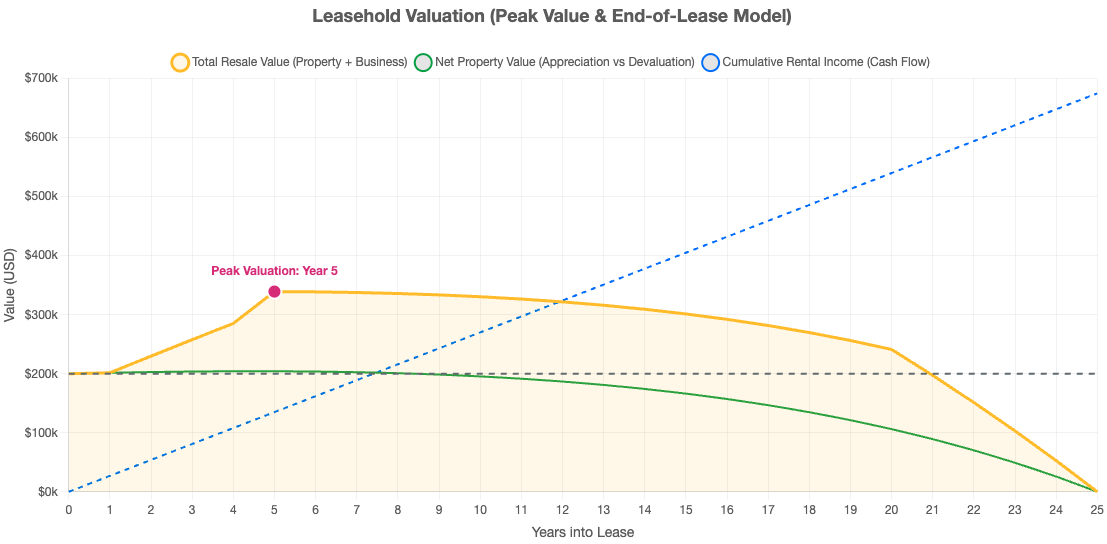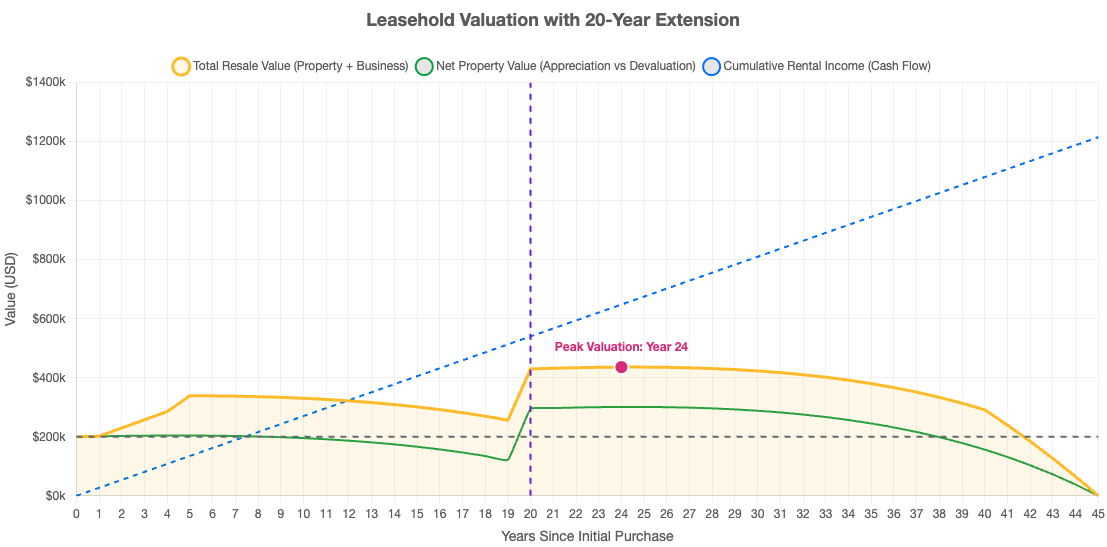How Bali leasehold villas defy depreciation
Leasehold properties in Bali don't just depreciate. Learn the two key strategies that create real capital appreciation for savvy investors.
%20(1).jpg)
Yes, a Bali leasehold villa can absolutely appreciate in value, but it does so in a way that’s completely different from traditional real estate. Its appreciation is not passive, it is an active process born from a dynamic interplay between strategic location choice and transforming the property into a cash flowing business, which together counteract the lease’s natural depreciation.
The fundamental paradox of leasehold value
Alright, let’s get straight to it. There's a core concept we need to get our heads around. A leasehold is, at its heart, a long term rental agreement. Nothing more, nothing less.
In Bali, this means you are buying the right to use a property for a set number of years. So, logically, as each year passes, the remaining time on that agreement shrinks, and its intrinsic value ticks down. Think of it like a clock counting down.
If you do nothing, the value will, without exception, reach zero at the end of the lease term. No matter how much you paid, the residual value of the contract itself will be zero.
It’s a depreciating asset by definition.

So, how on earth do people make money? How does appreciation happen?
It happens because we introduce two powerful external forces that push back against that downward clock. These forces don't just slow the depreciation, they can actually reverse it for a significant period, creating a window of powerful opportunity for profit.
- Locational gravity and market momentum. This is about choosing the right place at the right time. It's the appreciation of the area itself, driven by development, infrastructure, and growing demand. This is the first way your property gains value.
- The villa as a cash flowing business. This is about turning the property from a simple dwelling into an income generating asset through rentals. A business has a value far beyond its physical components. This is the second, more active way your property appreciates.
- The strategic exit. Understanding when these two forces create a peak valuation is key to realizing your profit. It's an active investment, not a passive one.
Riding the wave of area development
Let's talk about that first force, the power of location.
Bali’s property market is not one single entity, it's a collection of rapidly evolving micro markets. We all saw what happened in Canggu, it transformed from a sleepy surf town into a global hotspot, and property values skyrocketed. Now we’re seeing a similar trajectory in places like Uluwatu. Newly developing infrastructure, urban development, and growing area fame all positively impact your investment.
When you buy a leasehold in an area on an upward curve, the increasing value of the land and the desirability of the location create a powerful lift.
This appreciation of the area directly opposes the natural depreciation of your lease contract. For the first several years of your lease, say years one through ten of a twenty five year lease, the growth in the area’s value can be so strong that it completely overshadows the lease’s depreciation.
This creates a fascinating curve. The net value of your property doesn't just go down, it can actually go up first.
It kind of balloons down over the long term, but there are sweet spots between the fifth and tenth year where the value is greater than your initial investment.

Of course, a crucial question is what happens if you renew the lease. Renewing or extending the lease is like hitting a reset button. The property value doesn't go to zero, it instead inherits the value of the land and building based on current market rates.
An extension injects a massive amount of value back into the asset (more than what you pay) because you are replenishing its most crucial component, time.
This is the same concept as filling up your car tank with petrol before it runs out, You can go further in distance the same way you can rent out a villa for longer periods of time.

Transforming your villa into a business engine
Now for the second, and arguably more controllable, force. This is something that will stack on top of urban development appreciation. Your property has to work for you.
Rent, plain and simple. Whether it's short term, mid term, or long term, the property must generate income.
If it generates income, it can be considered a business, and a business is worth as much as the money it can generate plus the property value.
Let's use a real world example. Suppose you invest USD 220,000 in a villa. With current market conditions, you rent it out short term and achieve an average 77% occupancy rate with an average daily rate (ADR) of $150. Your total operating costs, including taxes, fees, and utilities, are about 35% of the revenue.
What does this look like? You are looking at a 12.5% yearly net income, which is roughly USD 27,000 in your bank account, or about $2,300 per month. Your investment will essentially pay for itself in about seven years. Great.
When you decide to sell, you aren't just selling the remaining years on the lease. You are selling a turnkey business operation.
A buyer is acquiring the property plus its established income stream.
This is how you can be five years into a lease and sell for more than you paid. Let’s look at the numbers for a five year exit strategy.

As the table shows, this strategy projects a positive net profit. The estimated sale price is based on the proven business performance, not just the depreciating lease. And keep in mind, that calculation doesn't even fully account for the property appreciation itself. If we add a conservative 5% per year compounded for five years, that’s roughly another $60,000 in value. Now your property is worth closer to USD 290,000, just because it is a working rental business in a growing area.
The symphony of value and strategic exit
So you see, there is indeed capital appreciation with leasehold in Bali.
It is absolutely not in the traditional sense you might find in Europe. It requires extra steps. When you plot all these forces on a graph, you see a beautiful, complex orchestra of lines.
You have the downward slope of the lease depreciation, contrasted by the growth curve from area development, and the income line which also increases the growth. Do not focus on the precise values, but on the meaning and lifecycle. This is something every Bali real estate investor will experience.

While the following chart is the cherry on the cake and it represent the entire lifecycle of one single property including the lease extension, in this example 20 years. You can clearly see how much time and opportunity is ahead of you with leasehold Bali villas.

Now you are probably wondering, why expose myself to this risk? Why would anyone do it in a market like Indonesia and Bali?
Because it pays well.
In Europe, if you are not crushed by taxation, competition, and maintenance costs, you might manage an 8% yield, but inflation will probably erase it.
The risk you take in Bali is compensated by higher opportunity. Taxation is more favorable, operative costs will not crush you, and you can have a team managing your villa while you collect payments. The returns are surprising.
When we set up clients with a fully turnkey and managed investment villa, they see returns around 14 to 18% on average, without even needing to be here.
Conclusion
So, let's circle back. Investing in a Bali leasehold is a completely different mindset from the buy and hold strategy you might be used to. It is not passive. It demands foresight to choose developing areas and a pragmatic approach to generate income. You are not just buying property, you are buying into a dynamic ecosystem and building a small business on top of it. The appreciation is real, it's substantial, and it’s earned through strategy, not by simply waiting.
At The Bali Homes we do just that, see why you should invest in Bali now.
.jpg)




